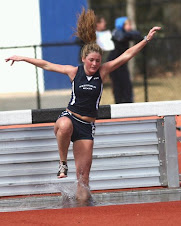Sunday, November 9, 2008
Exercise as a Stress Management Modality
The most common causes of stresses can be brought about by a traumatic accident, death, or emergency situation. Stress can also be a side effect of a serious illness or disease. The daily life stressors include the workplace and family responsibilities. Some early signs of stress include headache, sleep disorders, difficulty concentrating, short-temper, upset stomach, job dissatisfaction, low morale, depression, and anxiety, which all negatively affect health.
The way that I tend to deal with stress in my life is mainly by exercise. Being on the cross-country team helps a lot because it is fun for me and it gives me a break from my school work and time to socialize with friends. Common ways that others tend to deal with stress is by relaxing, making time for yourself, getting enough sleep, eating right, physical activity, talking to friends, writing down thoughts, helping others, planning your time, and getting a hobby. It's important for your health and well being to handle stress in these healthy than to handle it in unhealthy ways such as drinking too much alcohol, doing drugs, or overeating. If worst comes to worst than seek professional help. A therapist can help you work through stress and find better ways to deal with problems. There also are medications that can help ease symptoms of depression and anxiety and help promote sleep.
Since my blog is based on running and physical activity I wanted to let you know why physical activity is good for stress. getting physical activity not only helps relieve your tense muscles, but helps your mood too! Your body makes certain chemicals, called endorphins, before and after you work out. They relieve stress and improve your mood. It also can give you a break from whatever is stressing you out!
Reference: http://www.4women.gov/FAQ/stress-your-health.cfm#1
Tuesday, November 4, 2008
Loving Yourself Inside and Out!

I decided to write this blog on body image as a brief introduction to my health promotion commercial, and also because running and exercise can help women feel happier about their bodies. A lot of women suffer from a distorted body image, and perceive types of their body unlike they really are. Women are constantly pressured to have the “Barbie Doll” or model type body by our media and people in our lives, and this can lead to emotional distress, low self-esteem, dieting, anxiety, depression, and eating disorders. Being extremely thin is considered beautiful in our culture, and for most people this is very difficult and/or impossible to achieve and maintain. Did you know that only about 5 percent of women fall under this criterion of thin? These women that are naturally thin also often have small breasts, so the images of women that we see in the media most likely have implants or are completely perfected on the computer. Since you’ve learned that the model image, for the most part, is made up, here are some ways that you can feel more comfortable with your body and achieve some health benefits at the same time. Eat healthily, exercise regularly, and get plenty of rest. Eating healthily can promote healthy skin and hair, along with strong bones. Regular exercise can boost self-esteem, self-image, mood, and energy levels. Getting plenty of rest is key to stress management. It’s not fair that women have to deal with the anxiety, stress, and discomfort daily with pressures to be “perfect.” Women should be made to feel comfortable with their bodies and deal with anxieties in a healthy way!
Reference: http://www.4woman.gov/bodyimage/
Sunday, October 26, 2008
Exercising in Hot or Cold Weather





The weather is changing quickly on us! Last week it started getting so cold, and today it was warm again. I don't know how to dress outside, especially on my runs. I like that the weather is getting cooler though. Running when it's cold outside is a lot easier for me than summer training was in the sweltering heat! I guess everyone's different; some runners actually prefer running in the heat. They need to make sure they prepare for it by staying well hydrated by drinking plenty of water and fluids, so they do not get heat stress. Heat stress occurs when your body's rate of heat production can exceed its ability to cool itself, and usually happens when you exercise in warm, humid weather. The three different heat stress illnesses are heat cramps, heat exhaustion, and heat stroke. Heat cramps can be prevented by warm-ups and hydrating properly. Heat exhaustion is caused by excessive water loss resulting from prolonged exercise, and is a mild form of shock. When experiencing this you will feel nausea, head ache, fatigue, dizziness, chills, and the skin will be cool and moist. Heat stroke is a life threatening emergency with a 20-70% death rate. It occurs during vigorous exercise when the body's heat production significantly exceeds its cooling capacities. It can cause brain damage, permanent disability, and death. Signs of this are dry, hot, and red skin; very high body temperature, and rapid heart rate. If you experience any of these symptoms from any of the heat stress illnesses, stop exercising and drink plenty of fluids.
Monday, October 20, 2008
The less you weigh the faster you'll go, Not for Long!
Anorexia is one of the most common eating disorders, and people who have it have an intense fear of gaining weight. They severely limit the amount of food they eat and can become dangerously thin. This eating disorder affects both the mind and body. An anorexic person views themselves as overweight, while everyone else views them as extremely thin. If anorexia is not treated early, it can become a lifelong problem. It can lead to osteoporosis, kidney damage, and heart problems which ultimately lead to early death.
Anorexia most likely develops if other people in the family are obese, have an eating disorder, or have a mood disorder such as depression or anxiety. It is also common if the person does a sport that stresses body size such as ballet, gymnastics, running or wrestling. It’s common in people that try to be perfect all of the time and are dealing with stressful life events. Anorexia affects less than 1 percent of the population and is most common in teens and women.
People who suffer from anorexia strongly deny that they have a problem or honestly believe that they do not have a problem. It is usually up to their loved ones to get them help. An anorexic’s life becomes focused on losing weight, and they may obsess about food, weight, and dieting. They also may exercise a lot even when they are sick, or vomit, use laxative, and water pills to avoid gaining weight. They may develop odd habits about food, or become secretive to avoid eating around others. When starvation mode sets they start to develop signs of serious problems throughout the body such as feeling weak, having thinning hair, dry skin, or brittle nails, stop having menstrual periods, feeling cold all the time, having low blood pressure and a sow heartbeat, having purplish skin color their arms and legs, having swollen feet and hands, and growing a layer of baby-fine hair all over the body. I found this article from the New York Times on a track and field high school athlete that describes going through the anorexia and then recovering from it. Check it out: http://query.nytimes.com/gst/fullpage.html?res=9A05EEDD1339F936A35757C0A960958260
Reference: http://www.webmd.com/mental-health/anorexia-nervosa/anorexia-nervosa-topic-overview
Monday, October 13, 2008
The Common Cold hits Westfield State
I decided to write this weeks blog on the common cold because it has been spreading from person to person on the Westfield State campus the past few weeks. Last week it hit my cross-country team hard, and had a negative impact on some of my teammates practices and races. On Tuesday’s workout the women’s team was dropping like flies, and on Saturday’s race two of our top runners finished about a minute slower than usual.
Colds are responsible for more days lost from work and more uncomfortable days spent at work than any other minor illness. The common cold can be caused by any number of different viruses, and are always present throughout the world. It is possible to catch a cold from the airborne droplets of another person’s sneeze or from skin-to skin contact. The best way to avoid the common cold is to eat healthily, washing your hands regularly, get adequate rest, stress reduction, regular exercise, and avoiding those with a newly developed colds as best as possible. If you get a cold, drink lots of fluids, bed rest, and take over-the-counter preparations to relieve symptoms.
Reference: Health the Basics by Rebecca J. Donatelle

Monday, October 6, 2008
Common Injuries in Running and Prevention
Injuries in running are very common from the constant pounding of the legs on a hard surface. To prevent injury our coach has a train on various surfaces. For instance, some days we will run on the road, some days we will run on the track, some days we will do trails in the woods, and sometimes we will even swim instead of running. The most common injury in runners is knee injuries. It is patellofemoral pain syndrome commonly referred to as runners knee. It occurs when a mistracking kneecap (patella) irritates the femoral groove in which it rests on the thighbone (femur). There are many reasons of how this can occur. It can be from overuse, a biomechanical problem, worn cartilage, high-arched feet, or muscular causes. Symptoms include tenderness behind or around the patella, usually toward its center. You may feel pain toward the back of the knee, a sense of cracking or that the knee's giving out. To prevent runners knee run on softer surfaces when possible. You may even have to cut down on some mileage too.Also, strengthening your quadriceps will improve patellar tracking, and stretching your hamstrings and calves will prevent overpronation.
Here are some stretches that you could do to prevent runners knee:
Hamstring Stretch: Stand in front of a chair, bench, or high step and place your left heel on it. Keep your back straight and lean forward from the hips until you feel a stretch down the back of the leg. Hold for 30 to 60 seconds, switch sides, and repeat. Perform two or three stretches per leg.
Straight Leg Lifts: Lie down, bend your left knee, and plant your left foot on the ground. Take two to four seconds to raise and lower your right leg (30 to 60 degrees), keeping the knee relatively straight with a slight bend. Do 10 repetitions, switch legs, and repeat the sequence to complete one set. Work up to 10 sets of 10 reps each.
Here’s a video of some exercises you could do for injury prevention!
Thursday, October 2, 2008
THE FIRE WITHIN! Boost Your Metabolism!

Your body burns calories in three ways: Resting Metabolic Rate (RMR), Thermic effect of food, and activity. For some quick background information the RMR is the number of calories your body need just to keep your brain, heart, and cell functions going. This accounts for 60% of your metabolism. You burn somewhere between 50 to 200 calories a day by digesting and processing the food you eat. This is the thermal effect of food and accounts for 5% of your total caloric burn. Activity includes all daily movements, from going on a run to typing on your keyboard, and it accounts for 35% of your total caloric burn.
Here are 10 easy ways to burn more calories all day long.
1. Drink Green Tea! Green Tea contains a phytochemical called ECGC, which can cause the body to waste calories as heat, thus speeding calorie burn.
2. Spice things up! Add hot peppers to your meals.
3. Eat protein at every meal! Your digestive tract has to work harder to break down protein than it does to break down carbohydrate, which increases caloric burn during digestion. This doesn't mean you should switch to a high-protein diet, however, since runners need carbohydrates for muscle fuel. Instead, include some low-fat protein with every meal or snack to boost calorie burn.
4. Eat fish and flax. New research shows that omega-3 fatty acids encourage your fat cells to send the "we're full" signal to your brain. This, in turn, causes the brain to send the signal to your metabolism to burn more calories.
5. Switch to healthy fats. Switching from saturated fats (such as butter) to monounsaturated fats (such as olive or canola oil) increases caloric burn.
6. Consume more dairy products. Calcium plays a key role in regulating fat-cell metabolism and fat storage.
7. Eat Regularly.
8. Eat more. Chronic calorie restriction trains your body to survive on fewer calories. As you eat fewer and fewer calories, your body adapts by slowing your metabolism.
9. Run Harder. If you add more miles to your current running program, you'll burn more calories. If you don’t want to run more mileage than increase the intensity by adding 60 to 90 second surges.
10. Lift Weights. The more muscle you have, the more calories you'll burn all day long. And it only takes two workouts a week to make a difference.














